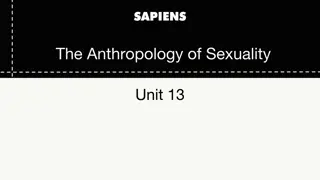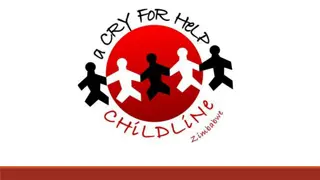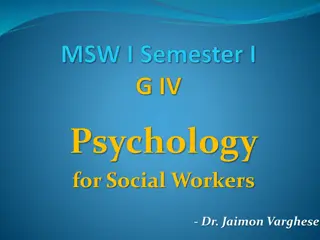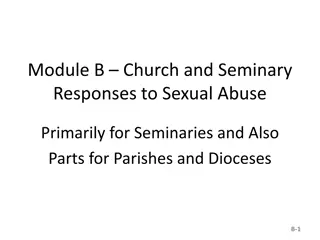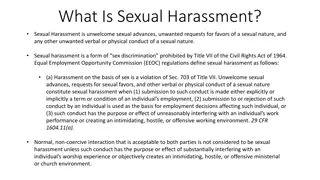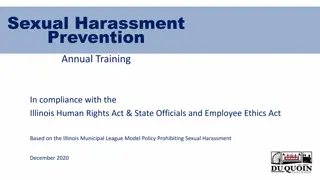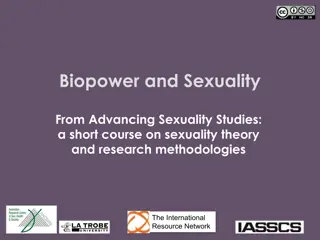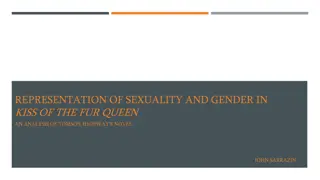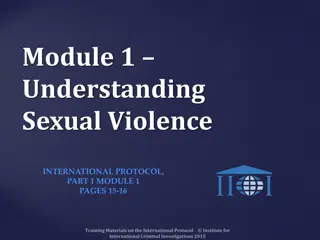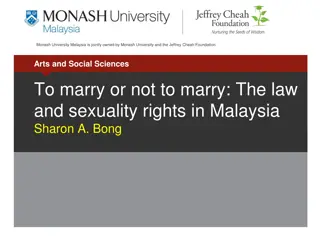Human Sexuality and Sexual Behavior
Human sexuality is a complex interplay of anatomy, physiology, culture, relationships, and developmental experiences throughout life. Normal sexual behavior involves mutual pleasure, devoid of guilt or compulsion. Sexuality is tightly intertwined with personality development, affecting motivations and behaviors beyond just libido. Explore the multifaceted nature of sexuality and its impacts on individual functioning and interactions.
Download Presentation

Please find below an Image/Link to download the presentation.
The content on the website is provided AS IS for your information and personal use only. It may not be sold, licensed, or shared on other websites without obtaining consent from the author.If you encounter any issues during the download, it is possible that the publisher has removed the file from their server.
You are allowed to download the files provided on this website for personal or commercial use, subject to the condition that they are used lawfully. All files are the property of their respective owners.
The content on the website is provided AS IS for your information and personal use only. It may not be sold, licensed, or shared on other websites without obtaining consent from the author.
E N D
Presentation Transcript
Ali Sahraian Psychiatrist Professor at Shiraz University of Medical Sciences Sex and Couple Therapist from McGill University, Canada
Human Sexuality and Sexual Dysfunctions Sexuality is determined by anatomy, physiology, the culture in which a person lives, relationships with others, and developmental experiences throughout the life cycle. It includes the perception of being male or female and private thoughts and fantasies as well as behavior. To the average person, sexual attraction to another person and the passion and love that follow are deeply associated with feelings of intimate happiness.
Normal sexual behavior brings pleasure to oneself and one's partner and involves stimulation of the primary sex organs including coitus; it is devoid of inappropriate feelings of guilt or anxiety and is not compulsive. Societal understanding of what defines normal sexual behavior is inconstant and varies from era to era, reflecting the cultural mores of the time.
Normal Sexuality Sexuality and total personality are so entwined that to speak of sexuality as a separate entity is virtually impossible. The term psychosexual, therefore, is used to describe personality development and functioning as these are affected by sexuality. The term psychosexual applies to more than sexual feelings and behavior, and it is not synonymous with libido.
Labeling of all pleasure-seeking behaviors as sexual makes it impossible to specify precise motivations. Persons may also use sexual activities for gratification of nonsexual needs, such as dependency, aggression, power, and status. Although sexual and nonsexual impulses can jointly motivate behavior, the analysis of behavior depends on understanding the underlying individual motivations and their interactions.
PSYCHOSEXUAL FACTORS Sexuality depends on four interrelated psychosexual factors: sexual identity, gender identity, sexual orientation, and sexual behavior. These factors affect personality, growth, development, and functioning. Sexuality is something more than physical sex, coital or noncoital, and something less than all behaviors directed toward attaining pleasure.
Sexual Identity Sexual identity is the pattern of a person's biological sexual characteristics: chromosomes, external genitalia, internal genitalia, hormonal composition, gonads, and secondary sex characteristics. In normal development, these characteristics form a cohesive pattern that leaves a person in no doubt about his or her sex.
Gender Identity Gender identity is a person's sense of maleness or femaleness. Sexual identity and gender identity are interactive. Genetic influences and hormones affect behavior, and the environment affects hormonal production and gene expression
Gender Identity In infants with an unambiguous sexual identity, almost everyone has a firm conviction that "I am male" or "I am female" by 2 to 3 years of age. Yet, even if maleness and femaleness develop normally, persons must still develop a sense of masculinity or femininity.
Gender Identity formation of gender identity arises from parental and cultural attitudes, the infant's external genitalia, and a genetic influence, which is physiologically active by the sixth week of fetal life. Although family, cultural, and biological influences may complicate establishment of a sense of masculinity or femininity, persons usually develop a relatively secure sense of identification with their biological sex-a stable gender identity.
GENDER ROLE Related to, and in part derived from, gender identity is gender role behavior. gender role behavior :all those things that a person says or does to disclose himself or herself as having the status of boy or man, girl or woman, respectively. A gender role is not established at birth but is built up cumulatively through ( 1 ) experiences encountered and transacted through casual and unplanned learning, (2) explicit instruction and inculcation, and (3) spontaneously putting two and two together to make sometimes four and sometimes five. The usual outcome is a congruence of gender identity and gender role..
Sexual Orientation Sexual orientation describes the object of a person's sexual impulses: heterosexual (opposite sex), homosexual (same sex), or bisexual (both sexes). A group of people have defined themselves as "asexual" and assert this as a positive identity. Some researchers believe this lack of attraction to any object is a manifestation of a desire disorder. Other people wish not to define their sexual orientation at all and avoid labels. Still others describe themselves as polysexual or pansexual.
The Central Nervous System and Sexual Behavior Cortex Limbic System Brainstem Brain Neurotransmitters: dopamine, epinephrine, norepinephrine, and serotonin,
GENDER DIFFERENCES IN DESIRE AND EROTIC STIMULI In measuring desire by the frequency of spontaneous sexual thoughts, interest in participating in sexual activity, and alertness to sexual cues, males generally possess a higher baseline level of desire than do women, which may be biologically determined. Motivations for having sex, other than desire, exist in both men and women, but seem to be more varied and prevalent in women. In women they may include a wish to reinforce the pair bond, the need for a feeling of closeness, a way of preventing the man from straying, or a desire to please the partner.
SEX HISTORY I. Identifying data A. Age B. Sex C. Occupation D. Relationship status-single, married, number of times previously married, separated, divorced, cohabiting, serious involvement, casual dating (difficulty forming or keeping relationships should be assessed throughout the interview) E. Sexual orientation-heterosexual, homosexual, or bisexual (this may also be ascertained later in the interview)
Current functioning A. Unsatisfactory to highly satisfactory B. If unsatisfactory, why? C. Feeling about partner satisfaction
Current functioning D. Dysfunctions?-e.g., lack of desire, erectile disorder, inhibited female interest/arousal, anorgasmia, premature ejaculation, retarded ejaculation, pain associated with intercourse (dysfunction discussed below) 1 . Onset-lifelong or acquired a. If acquired, when? b. Did onset coincide with drug use (medications or illegal recreational drugs), life stresses (e.g., loss of job, birth of child), interpersonal difficulties 2 . Generalized-occurs in most situations or with most partners 3 . Situational a. Only with current partner b. In any committed relationship c. Only with masturbation d. In socially proscribed circumstance (e.g., affair) e. In definable circumstance (e.g., very late at night, in parental home, when partner initiated sex play)
Current functioning E. Frequency-partnered sex (coital and noncoital sex play) F. Desire/libido-how often are sexual feelings, thoughts, fantasies, dreams, experienced? (per day, week, etc.) G. Description of typical sexual interaction 1 . Manner of initiation or invitation (e.g., verbal or physical? Does same person always initiate?) 2 . Presence, type, and extent of foreplay (e.g., kissing, caressing, manual or oral genital stimulation) 3 . Coitus? positions used? 4. Verbalization during sex? if so, what kind? 5. Afterplay? (whether sex act is completed or disrupted by dysfunction); typical activities (e.g., holding, talking, return to daily activities, sleeping) 6. Feeling after sex: relaxed, tense, angry, loving
Current functioning Sexual compulsivity?-intrusion of sexual thoughts or participation in sexual activities to a degree that interferes with relationships or work, requires deception and may endanger the patient
Past sexual history Childhood sexuality 1 . Parental attitudes about sex-degree of openness of reserve (assess unusual prudery or seductiveness) 2 . Parents' attitudes about nudity and modesty 3 . Learning about sex a. From parents? (initiated by child's questions or parent volunteering information? which parent? what was child's age?) subjects covered (e.g., pregnancy, birth, intercourse, menstruation, nocturnal emission, masturbation) b. From books, magazines, or friends at school or through religious group? c. Significant misinformation d. Feeling about information
Past sexual history 4 . Viewing or hearing primal scene-reaction? 5. Viewing sex play or intercourse of person other than parent 6. Viewing sex between pets or other animals
Childhood sex activities 1 . Genital self-stimulation before adolescence; age? reaction if apprehended? 2 . Awareness of self as boy or girl; bathroom sensual activities? (regarding urine, feces, odor, enemas) 3 . Sexual play or exploration with another child (playing doctor)-type of activity (e.g., looking, manual touching, genital touching); reactions or consequences if apprehended (by whom?)
Adolescence A. Age of onset of puberty-development of secondary sex characteristics, age of menarche for girl, wet dreams or first ejaculation for boy (preparation for and reaction to) B. Sense of self as feminine or masculine-body image, acceptance by peers (opposite sex and same sex), sense of sexual desirability, onset of coital fantasies
Adolescence C. Sex activities 1 . Masturbation-age begun; ever punished or prohibited? method used, accompanying fantasies, frequency (questions about masturbation and fantasies are among the most sensitive for patients to answer) 2 . Homosexual activities-ongoing or rare and experimental episodes, approached by others? If homosexual, has there been any heterosexual experimentation? 3 . Dating-casual or steady, description of first crush, infatuation, or first love. 4 . Experiences of kissing, necking, petting ("making out" or "fooling around"), age begun, frequency, number of partners, circumstances, type(s) of activity 5 . Orgasm-when first experienced? (may not be experienced during adolescence), with masturbation, during sleep, or with partner? with intercourse or other sex play? frequency? 6. First coitus-age, circumstances, partner, reactions (may not be experienced during adolescence); contraception and/or safe sex precautions used
Adult sexual activities (may be experienced by some adolescents) A. Premarital sex 1 . Types of sex play experiences-frequency of sexual interactions, types and number of partners 2 . Contraception and/or safe sex precautions used 3 . First coitus (if not experienced in adolescence) age, circumstances, partner 4. Cohabitation-age begun, duration, description of partner, sexual fidelity, types of sexual activity, frequency, satisfaction, number of cohabiting relationships, reasons for breakup(s) 5. Engagement-age, activity during engagement period with fiance(e), with others; length of engagement
Adult sexual activities (may be experienced by some adolescents) B. Marriage (if multiple marriages have occurred, explore sexual activity, reasons for marriage, and reasons for divorce in each marriage) 1 . Types and frequency of sexual interaction-describe typical sexual interaction (see above), satisfaction with sex life? view of partner's feeling 2 . First sexual experience with spouse-when? what were the circumstances? was it satisfying? disappointing? 3 . Honeymoon-setting, duration, pleasant or unpleasant, sexually active, frequency? problems? compatibility? 4. Effect of pregnancies and children on marital sex
Adult sexual activities (may be experienced by some adolescents) 5. Extramarital sex-number of incidents, partner; emotional attachment to extramarital partners? feelings about extramarital sex 6. Postmarital masturbation-frequency? effect on marital sex? 7. Extramarital sex by partner-effect on interviewee 8. Menageatrois or multiple sex (swinging) 9. Areas of conflict in marriage (e.g., parenting, finances, division of responsibilities, priorities)
VI. Sex after widowhood, separation, divorce- celibacy, orgasms in sleep, masturbation, noncoital sex play, intercourse (number of and relationship to partners), other
Special issues A. History of rape, incest, sexual or physical abuse B. Spousal abuse (current) C. Chronic illness (physical or psychiatric) D. History or presence of sexually transmitted diseases E. FertiIity problems F. Abortions, miscarriages, or unwanted or illegitimate pregnancies G. Gender identity conflict-(e.g., transsexualism, wearing clothes of opposite sex) H . Paraphilias-(e.g., fetishes, voyeurism, sadomasochism)
Sexual Dysfunctions The essential features of sexual dysfunctions are an inability to respond to sexual stimulation, or the experience of pain during the sexual act. Dysfunction can be defined by disturbance in the subjective sense of pleasure or desire usually associated with sex, or by the objective performance
Sexual Dysfunctions Sexual dysfunctions can be lifelong or acquired, generalized or situational, and result from psychological factors, physiological factors, combined factors, and numerous stressors including prohibitive cultural mores, health and partner issues, and relationship conflicts. If the dysfunction is attributable entirely to a general medical condition, substance use, or adverse effects of medication, then sexual dysfunction due to a general medical condition or substance-induced sexual dysfunction is diagnosed. In DSM-5, specification of the severity of the dysfunction is indicated by noting whether the patient's distress is mild, moderate, or severe
Sexual Dysfunctions Sexual dysfunctions are frequently associated with other mental disorders, such as depressive disorders, anxiety disorders, personality disorders, and schizophrenia. In many instances, a sexual dysfunction may be diagnosed in conjunction with another psychiatric disorder. If the dysfunction is largely attributable to an underlying psychiatric disorder, only the underlying disorder should be diagnosed.
Male Hypoactive Sexual Desire Disorder This dysfunction is characterized by a deficiency or absence of sexual fantasies and desire for sexual activity for a minimum duration of approximately 6 months . Men for whom this is a lifelong condition have never experienced many spontaneous erotic/sexual thoughts. Minimal spontaneous sexual thinking or minimal desire for sex ahead of sexual experiences is not considered a diagnosable disorder in women, particularly if desire is triggered during the sexual encounter.
The reported prevalence of low desire is greatest at the younger and older ends of the age spectrum, with only 2 percent of men ages 16 to 44 affected by this disorder
Some men may confuse decreased desire with decreased activity. Their erotic thoughts and fantasies are undiminished, but they no longer act on them due to health issues, unavailability of a partner, or another sexual dysfunction such as erectile disorder.
Loss of desire may also be an expression of hostility to a partner or the sign of a deteriorating relationship. The presence of desire depends on several factors: biological drive, adequate self-esteem, the ability to accept oneself as a sexual person, the availability of an appropriate partner, and a good relationship in nonsexual areas with a partner. Damage to, or absence of, any of these factors can diminish desire.
Female Sexual Interest/ Arousal Disorder The combination of interest (or desire) and arousal into one dysfunction category reflects the recognition that women do not necessarily move stepwise from desire to arousal, but often experience desire synchronously with, or even following, beginning feelings of arousal.
women experiencing sexual dysfunction may experience either/or both inability to feel interest or arousal, and they may often have difficulty achieving orgasm or experience pain in addition. Some may experience dysfunction across the entire range of sexual response/pleasure. Complaints in this dysfunction category present variously as a decrease or paucity of erotic feelings, thoughts, or fantasies; a decreased impulse to initiate sex; a decreased or absent receptivity to partner overtures; or an inability to respond to partner stimulation
Male Erectile Disorder Acquired male erectile disorder has been reported in 10 to 20 percent of all men. Freud declared it common among his patients. Erectile disorder is the chief complaint of more than 50 percent of all men treated for sexual disorders. Lifelong male erectile disorder is rare; it occurs in about 1 percent of men younger than age 35.
Male erectile disorder, however, is not universal in aging men; having an available sex partner is related to continuing potency, as is a history of consistent sexual activity and the absence of vascular, neurologic, or endocrine disease. Twenty percent of men fear erectile dysfunction prior to their first coitus; the reported incidence of actual erectile dysfunction during first coitus is 8 percent. As Stephen Levine has stated, the first sexual encounter "is a horse race between excitement and anxiety."
Female Orgasmic Disorder Female orgasmic disorder, sometimes called inhibited female orgasm or anorgasmia, is defined as the recurrent or persistent inhibition of female orgasm, as manifested by the recurrent delay in, or absence of orgasm after a normal sexual excitement phase that a clinician judges to be adequate in focus, intensity, and duration-in short, a woman's inability to achieve orgasm by coitus
Delayed Ejaculation In male delayed ejaculation, sometimes called retarded ejaculation, a man achieves ejaculation during coitus with great difficulty, if at all
Premature (Early) Ejaculation In premature ejaculation, men persistently or recurrently achieve orgasm and ejaculation before they wish to. The diagnosis is made when a man regularly ejaculates before or within approximately 1 minute after penetration. DSM-5 refers only to "vaginal penetration" in its diagnostic criteria, even though it is entirely possible for the disorder to occur in men who are homosexual and do not engage in vaginal penetration. DSM-5 defines the disorder as mild if ejaculation occurs within approximately 30 seconds to 1 minute of vaginal penetration, moderate if ejaculation occurs within approximately 15 to 30 seconds of vaginal penetration, and severe when ejaculation occurs at the start of sexual activity or within approximately 15 seconds of vaginal penetration.
Genito-Pelvic Pain/Penetration Disorder In DSM-5, this disorder refers to one or more of the following complaints, of which any two or more may occur together: difficulty having intercourse; genito- pelvic pain; fear of pain or penetration; and tension of the pelvic floor muscles. Previously, these pain disorders were diagnosed as dyspareunia or vaginismus. These former diagnoses could coexist or one could lead to the other and could understandably lead to fear of pain with sex. Thus, it is reasonable to gather these diagnoses into one diagnostic category. For the purposes of clinical discussion, however, the distinct categories of dyspareunia and vaginismus remain clinically useful.
Dyspareunia Dyspareunia is recurrent or persistent genital pain occurring before, during, or after intercourse. Dyspareunia is related to, and often coincides with, vaginismus. Repeated episodes of vaginismus can lead to dyspareunia and vice versa; in either case, somatic causes must be ruled out. A pain disorder should not be diagnosed when an organic basis for pain is found or when it is caused by a lack of lubrication. DSM- 5 cites that 15 percent of women in North America report recurrent pain during intercourse.
Vaginismus Defined as a constriction of the outer third of the vagina due to involuntary pelvic floor muscle tightening or spasm, vaginismus interferes with penile insertion and intercourse. This response may occur during a gynecological examination when involuntary vaginal constriction prevents the introduction of the speculum into the vagina. The diagnosis is not made when the dysfunction is caused exclusively by organic factors or when it is symptomatic of another mental disorder.
Vaginismus Vaginismus may be complete, that is no penetration of the vagina is possible, whether by the penis, fingers, a speculum during gynecologic exam, or even if the woman tries to use the smallest size tampon. In a less severe form of vaginismus, pelvic floor muscle tightening due to pain or fear of pain makes penetration difficult, but not impossible. Penetration may be achieved with the smallest size speculum or little fingers. In mild cases, the muscles relax after the initial difficulty with penetration and the woman can continue with sexual play, sometimes even with coitus.
SEXUAL DYSFUNCTION DUE TO A GENERAL MEDICAL CONDITION Male Erectile Disorder Due to a General Medical Condition Dyspareunia Due to a General Medical Condition Male Hypoactive Sexual Desire Disorder and Female Interest/ Arousal Disorder Due to a General Medical Condition
Other Male Sexual Dysfunction Due to a General Medical Condition Other Female Sexual Dysfunction Due to a General Medical Condition Substance/Medication-Induced Sexual Dysfunction (Antipsychotic Drugs, Antidepressant Drugs, Lithium, Sympathomimetics, a-Adrenergic and ,8-Adrenergic Receptor Antagonists, Anticholinergics, Antihistamines, Antianxiety Agents, Alcohol, Opioids, Hallucinogens, canabis, Barbiturates and Similarly Acting Drugs).


